Elevate your triathlon training with brick workouts! Uncover the importance of combining disciplines, enhancing endurance, and building mental resilience. Explore dynamic workout ideas to conquer race-day challenges.
Boost your triathlon game with these dynamic core exercises! From planks to mountain climbers, power up your core for enhanced stability, balance, and endurance. Dive into the journey of a stronger you!
Beat the heat while prepping for Kerrville Tri! Dive into our blog for refreshing swim workouts with a kickboard, designed for triathletes. Boost technique, endurance, and performance in the water. Let’s make a splash!
Beat the heat while prepping for Kerrville Tri! Dive into our blog for refreshing swim workouts with a kickboard, designed for triathletes. Boost technique, endurance, and performance in the water. Let’s make a splash!
Maximiliano gives some insight into training for his first half distance triathlon
Everyone’s triathlon journey is different. Some want a new challenge. Others like the steadiness of training and the thrill of competition. There are triathletes who want to create a healthier lifestyle for themselves. Sometimes people are overwhelmed and never start. Maximiliano is a Kerrville Tri Ambassador sharing his triathlon journey about what led him to register and train for his first half distance triathlon. It hasn’t been a smooth road for the new father, but he has the support of his family and the triathlon community. His journey is unique, but similar to many other triathletes. Learn about his start, the ups and downs, and what he’s learned along the way. It will all culminate in his first half distance triathlon at Kerrville Tri’s 10th anniversary! Whether it’s your first Rookie Sprint Tri or your 10th half distance, join Maximiliano at The Most Scenic Triathlon in Texas.
A crazy idea
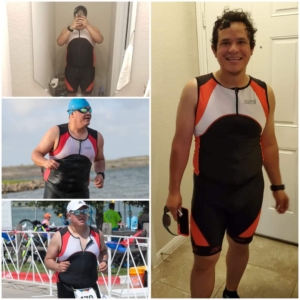
Maximiliano has gone from 255 lbs. (left) to 215 lbs. (right) since his first triathlon.
My name is Maximiliano Ramirez and my first son was born in February 2019. At that time I was in the worst physical shape of my life. I weighed 255 pounds and could not run more than two miles without getting exhausted. Seeing my son for the first time made me realize I had to make some changes to my life. That is when I got the crazy idea of participating in triathlons. With zero experience I bought my first used road bike online and registered for my first triathlon, Rookie Tri.
As you can imagine, I didn’t have much time to train (less than three months!). I was getting used to life as a father, but still managed to finish the race. But all I needed was that race to get hooked on triathlon. You can say I got the bug! I signed up for two more races that year, Lake Pflugerville Tri (Olympic distance) and Jack’s Genetic Tri. I was really pumped for the 2020 season, but as we all know Covid derailed events and training plans alike. During that time I was happy that I got an extra year to do more research. I learned more about training plans, different equipment, and how to take better care of myself. That gave me the courage to sign up for my first half distance triathlon at the 10th annual Kerrville Tri.
Continued support
When I made the decision to register for my first half distance triathlon, my wife, without hesitation, gave me her full support. Having her by my side throughout the training process has been incredible. I have researched many training plans and asked many of my friends for tips. I think asking for help is important to do. You never know what you’ll learn! Also, don’t be embarrassed to go out there and try something new, whether it’s new swim equipment or your longest bike ride.
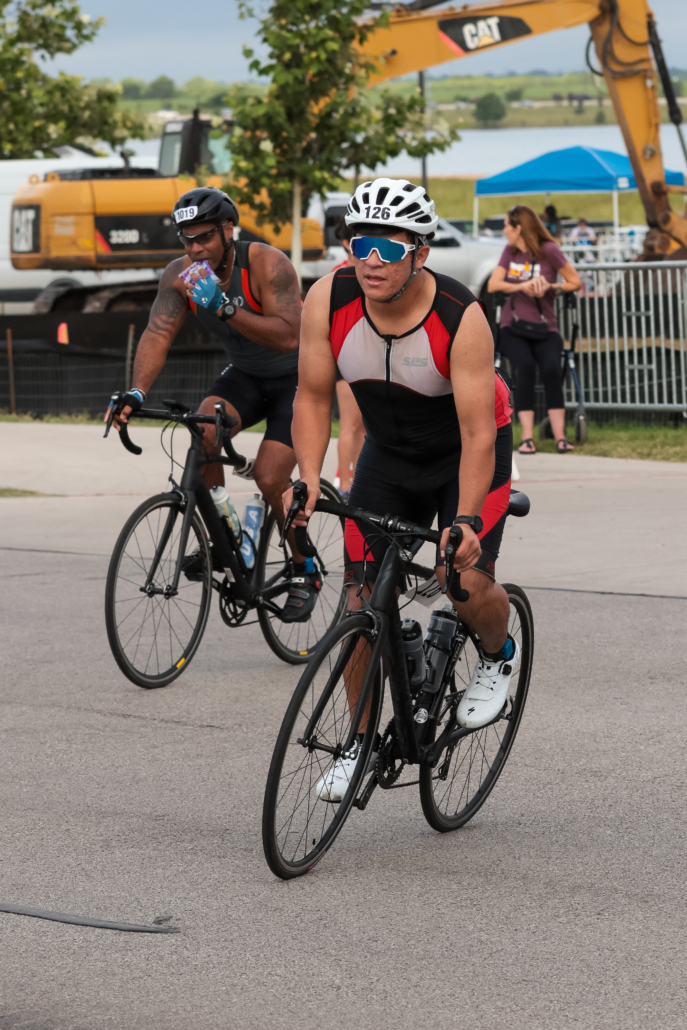
Maximiliano typically starts his long bike rides at 4:00 a.m.
My current training plan consists of two swimming days (Monday and Friday). That gives my legs time to recover before and after long weekend rides/runs. During the week I alternate between short runs and rides during my lunch break. Depending on how hectic my days are, there might be a day or two where I work out at night.
Tips to make training work
Like many other triathletes with families, work, and a busy life, finding time to train can be difficult. But really all you have to do is adjust your routine and schedule. For example, on my long rides, I typically go to sleep early so I can wake up around 4:00 a.m. This allows me to be out the door no later than 5:00 a.m. Making minor adjustments helps me balance training for my first half distance triathlon and everything else in my life.
In addition to the actual training plan, nutrition and hydration are just as important. Make sure to hydrate, especially with electrolytes, when training is demanding. I still consider myself a new triathlete and I’ve tried many products. Nothing has worked like I want just yet and I’ll continue to research and experiment until I find what works best for me. But just like training and certain workouts, you have to experiment with nutrition and hydration to discover what’s best for you.
I hope my experiences help others who want to register for a triathlon, but are nervous about jumping into something new. Just remember that anything is possible. You have to put in the work, but you should also be confident that you can achieve it. It will take time to get in a rhythm, but once you do it becomes second nature. Then you’ll graduate from sprint triathlons to your first half distance triathlon! I encourage everyone to join me at the 10th annual Kerrville Triathlon Festival. They have distances for triathletes of all abilities.
Grow as a swimmer when you transition from the pool to open water
The thought of swimming in open water can cause anxiety and feel overwhelming if you’re used to the clear waters of a pool. But don’t worry! It’s not as daunting as it seems. Transitioning from the pool to open water can be done easily by following some helpful tips. For example, if you want to become comfortable or more comfortable with open-water swimming, then you should swim in open water more often. Good news, all of our tips but one can be done in the pool! Start today and before you know it you’ll become more comfortable with taking your swim from the pool to open water. Pro tip: build your endurance in the open water with this Zone3 swim gear.
6 ways to become more comfortable
1) Keep your eyes closed
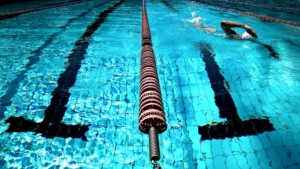
Close your eyes for a few strokes so you don’t focus on the line.
While swimming in the pool, keep your eyes closed for several strokes while your head faces down in the water. Increase the number of strokes as you become more comfortable. This will help you get a feel for swimming straight without needing to use the black line at the bottom of the pool as a reference.
2) Challenge yourself
This doesn’t have to be overwhelming, but there are a couple of different ways you can challenge yourself in the pool. First, try swimming in a pool that’s longer in length than what you currently train in. This will help build your stamina and get you used to swimming longer distances without stopping.
If you can’t access a longer pool, try moving your workout to earlier in the morning before the sunrises. This is beneficial if the pool isn’t lit and is similar to swimming with your eyes closed. Swimming when it’s darker outside can make it tougher to see. This provides an environment similar to what you’ll experience in open water.
3) Practice sighting
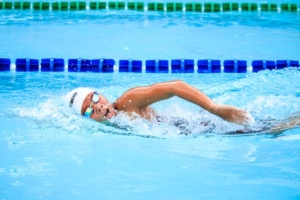
Get comfortable with sighting when you practice in the pool.
Sighting means you focus on something far away while swimming in open water. Focusing on that helps keep you from veering off course and swimming more than you have to. To practice sighting, you need to synchronize looking ahead with your stroke and breathing. Look at a target at the end of the lane, swim for two strokes, look at your target, repeat. This will help you become more comfortable with sighting in open water and keep you on course. Don’t swim extra if you don’t have to!
4) Learn to be efficient
In order to be an efficient swimmer, you need to reduce your stroke count for each lap. Sighting will help you become more efficient too. It takes fewer strokes and less energy if you swim in a straight line versus zig-zagging in the water. Taking in the right amount of oxygen when you breathe can help you become more efficient too. Keep your form the same as often as you can so you don’t over-extend yourself and feel like you have to play catch up.
5) Wear your wetsuit
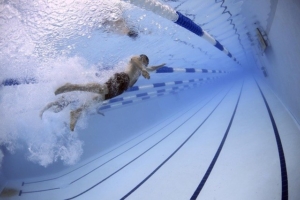
Focus on your form and breathing in the pool to become more efficient.
If you plan to wear a wetsuit during your event, you need to become familiar with it before race day. If you do this in the pool, know that chlorine can be harmful to your wetsuit. Wearing it before your race allows you to gauge the buoyancy of the wetsuit and its impact on your form and stroke. Learn about the pros and cons of wearing a wetsuit before you purchase one.
6) Swim in open water
This would be a great time to get familiar with your wetsuit! Find a lake or other body of water to practice swimming in open water. Doing this before race day will help you prepare for what you’ll experience. This is where all the work you’ve done in the pool gets used. You won’t have a black line to guide you, so sighting will be imperative so you can swim efficiently.
This advice will be beneficial in helping you transition from the pool to open water. As you practice in the pool, find what works for you and stick with it. Repetition in the pool is what will help you when you transition from the pool to open water. Ask other triathletes for their tips and advice, like advice on the best multisport watches. Who knows, the insight they provide might be useful for you.
Anyone who says “you can’t” complete a triathlon is wrong
No one should tell you that you can’t do something. Ever. This blog post will inspire people who want to train for a triathlon, but have been told in some way they shouldn’t. Triathlons are tough and require training, but don’t let anyone stop you from doing what your heart desires! Remember, anyone who says “you can’t” complete a triathlon is wrong; YOU CAN! These 11 steps will guide future triathletes through the process of preparing for their first race. For an extra boost, print out the PDF below and place it where you’ll see it every day!
11 beneficial steps for future triathletes
Find your heart’s desire
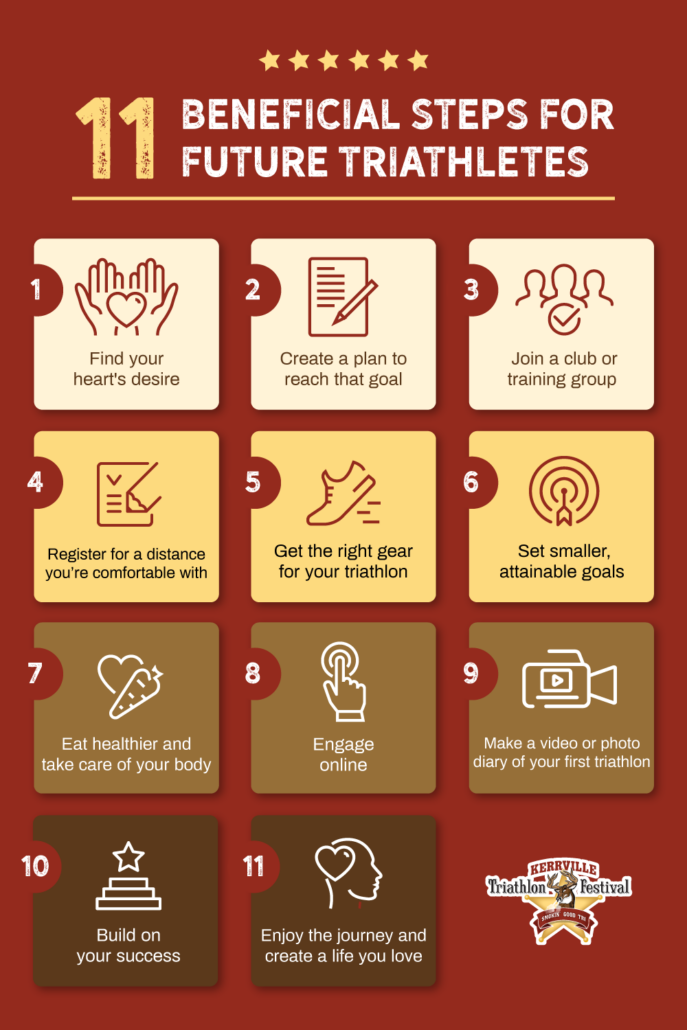 Why do you want to do this? Are you looking for structure that’ll lead to a healthy and active lifestyle? Let’s say you want to do it because you think you might like to be part of an active community. You’ve discovered that you really enjoy training with other people. You enjoy the challenge of pushing yourself and getting out of your comfort zone. As a social person, you like to be around other people more often than not. There are lots of reasons, find yours. That’s your starting point!
Why do you want to do this? Are you looking for structure that’ll lead to a healthy and active lifestyle? Let’s say you want to do it because you think you might like to be part of an active community. You’ve discovered that you really enjoy training with other people. You enjoy the challenge of pushing yourself and getting out of your comfort zone. As a social person, you like to be around other people more often than not. There are lots of reasons, find yours. That’s your starting point!
Create a plan to reach that goal
Do you want to do an Olympic triathlon? A sprint or half distance? Your training time frame is dependent upon the distance you want to complete. You’ll need at least 3 months to prepare for a sprint triathlon. If you’re thinking about your first half-distance triathlon, you’ll probably need a year. Once you determine your goal distance and training time frame, you should decide if you have a set finishing goal time or if your goal is to finish and have fun. Once you have your goal, there are tons of free online training plans or you can hire a professional coach.
Join a club or training group
There are plenty of groups around the world who will help you. Check your local community too. Chances are there’s a group that meets up for swims, rides, runs, and brick workouts. If there isn’t one in your area, start a group. It’s a great way to connect with other people who share your interest.
Register for a distance you’re comfortable with
If you’re just starting out, Kerrville Tri’s Rookie sprint distance is perfect. The Rookie distance includes a 300m swim, 14-mile bike ride, and 2-mile run. It’s an introductory distance that’s an ideal starting point and doesn’t require a longer training time frame. The shorter distance will give you the confidence to try a longer distance later. Check with your club or group, they might have discounts or a code that you may not know about.
Get the right gear for your triathlon
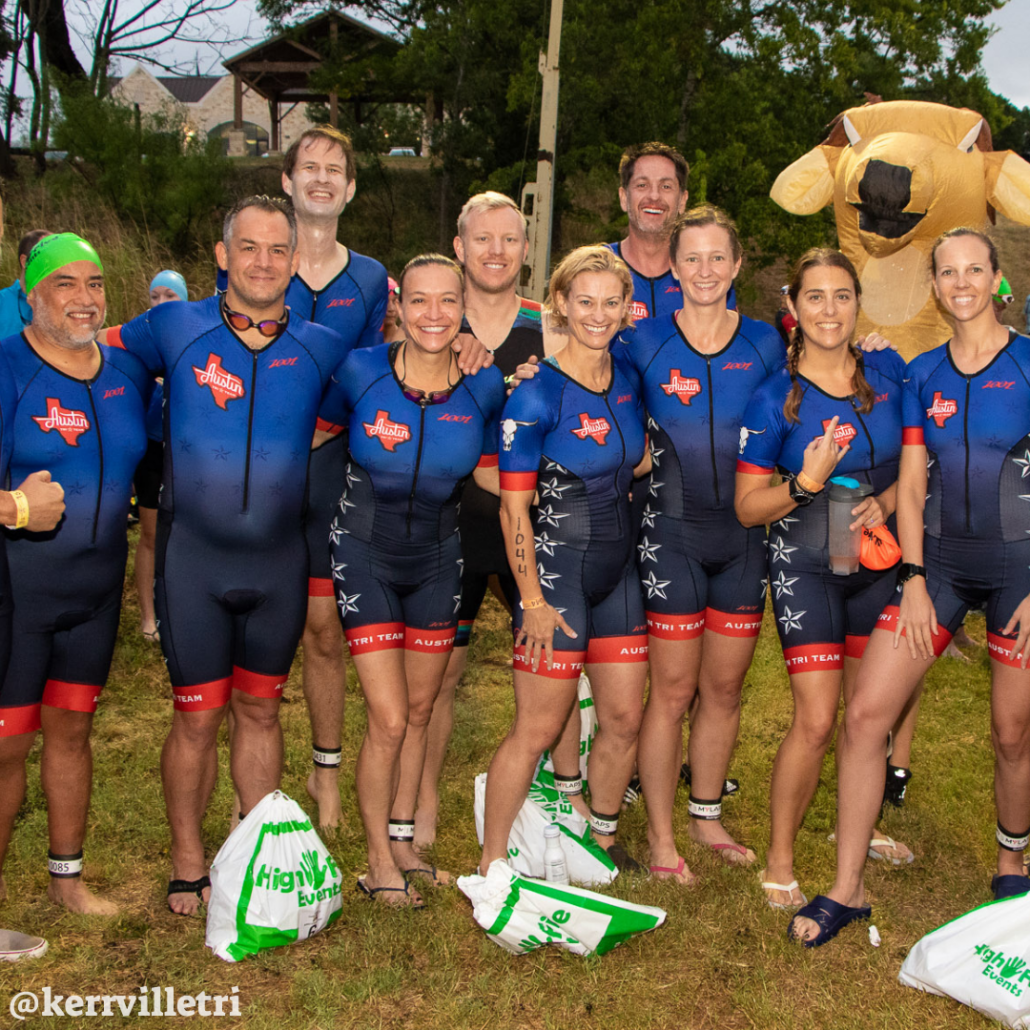
Join a triathlon group to meet other triathletes. Credit – Tom Marek
You’ll need a good bike and the right gear for training and competing. Train in the type of gear you’ll wear on race day. It’ll help you get comfortable with items like goggles, a wetsuit, or elastic laces in your running shoes. Make sure you buy a bike that fits you and your needs. Chances are there’s a bike shop near you that can help you find the perfect ride. Don’t start shopping until you read these bike buying dos and don’ts.
Set smaller, attainable goals
An example of a small goal when first starting out might be “Run my first mile without stopping.” Another example might be “Complete 2 swim workouts every week.” You could also “Work on bike skills” during a ride. Once these short-term goals become habits, set new ones that are slightly bigger so you can progressively work towards completing your future race! Remember: you have the power to change your body through exercise
Eat healthier and take care of your body
A well-balanced diet of fruits, vegetables, and protein is an excellent starting point for a healthier diet. You can’t out-train bad eating habits and you’ll need the energy for training. Don’t skip meals or count calories while training. Stay active during your non-training time. Take walks, foam roll, or ride bikes with friends if you want to stay active on rest days. These are excellent habits to establish before, during, and after training. Don’t underestimate the importance of rest days!
Engage online
Find inspiration when you engage on social media with the event you’re training for and the different triathlon communities. If you’re not sure where to start, join the Kerrville Triathlon Facebook Group and follow us on Instagram. Comment on posts with questions or request blog topics that you think would be helpful in your journey.
Make a video or photo diary of your first triathlon
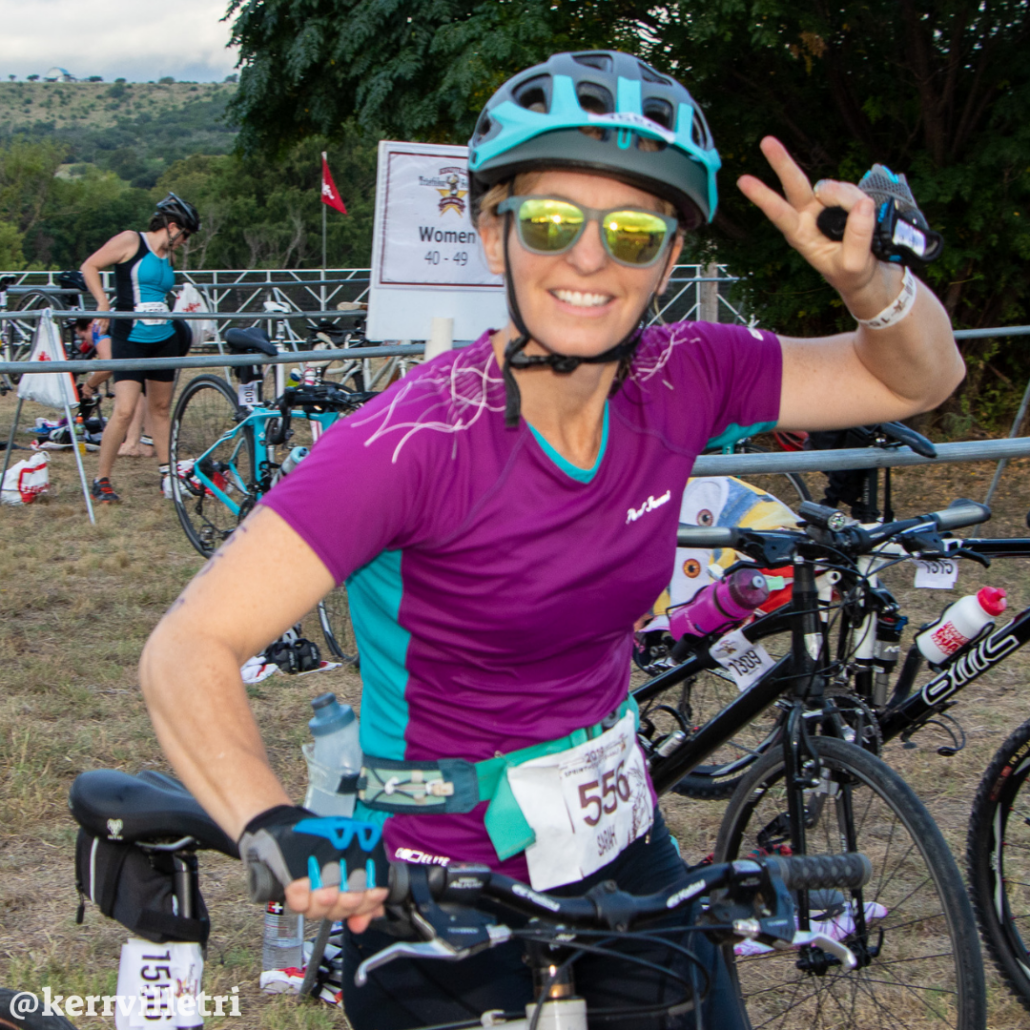
Enjoy race day and your triathlon journey. Credit – Tom Marek
This is a great way to document your progress and inspire others who have been following your journey. Share it on Instagram, Facebook, or any other social media account that would be helpful in reaching people who are looking for inspiration. This is also a great way to look back on your experience in its entirety. Plus, it’s a nice little reminder for the people who said you can’t complete a triathlon!
Build on your success
Don’t let bad days get you down, they happen. Miss a training day – no problem. Just pick up where you left off and keep going. Feeling under the weather? Take a day off. It’s important to keep the momentum going. Building on your success extends beyond training to the finish line. Once you achieve your main goal, don’t stop there. Find your next event and keep the training train rolling!
Enjoy the journey and create a life you’ll love
You never know what you’re capable of until you do it. Training for a triathlon can lead to a life that is full of amazing and supportive people, healthy habits, and a consistent confidence booster. Keep in mind that your smaller goals will lead to your main goal. Think of them as building blocks. Enjoy the journey because you’ll never train for your first triathlon after you cross the finish line.
Don’t let people tell you “you can’t.” Get inspired and train for a triathlon! You have the power to change your life through exercise. Training for a triathlon isn’t easy. Plan well, avoid these 6 mistakes, and be strategic so you can get your body ready to crush it. And if all of these things sound too hard? Let us know. Our team would love to share our expertise and help get you to the start line!
Keep your training on track when you avoid these common foot problems
Triathlon is one of the most demanding sports. You push your body to the limit in training and on race day in pursuit of your goals. Regardless of the demands and whether you’re a first-timer or a veteran, you love the sport and its community to keep coming back for more. Swimming, cycling, running, and even changing in transition can put tremendous pressure on every muscle and bone in the body. One of the most impacted areas can be your feet and ankles. They’re primarily involved in everything you do. As a result, common foot problems can arise. These can range from a minor annoyance during training to an issue that sidelines you for weeks. The following 3 common foot problems often arise from excessive pressure due to rigorous training. These 4 exercises can help with balance training and strengthening your feet and ankles.
Achilles tendonitis
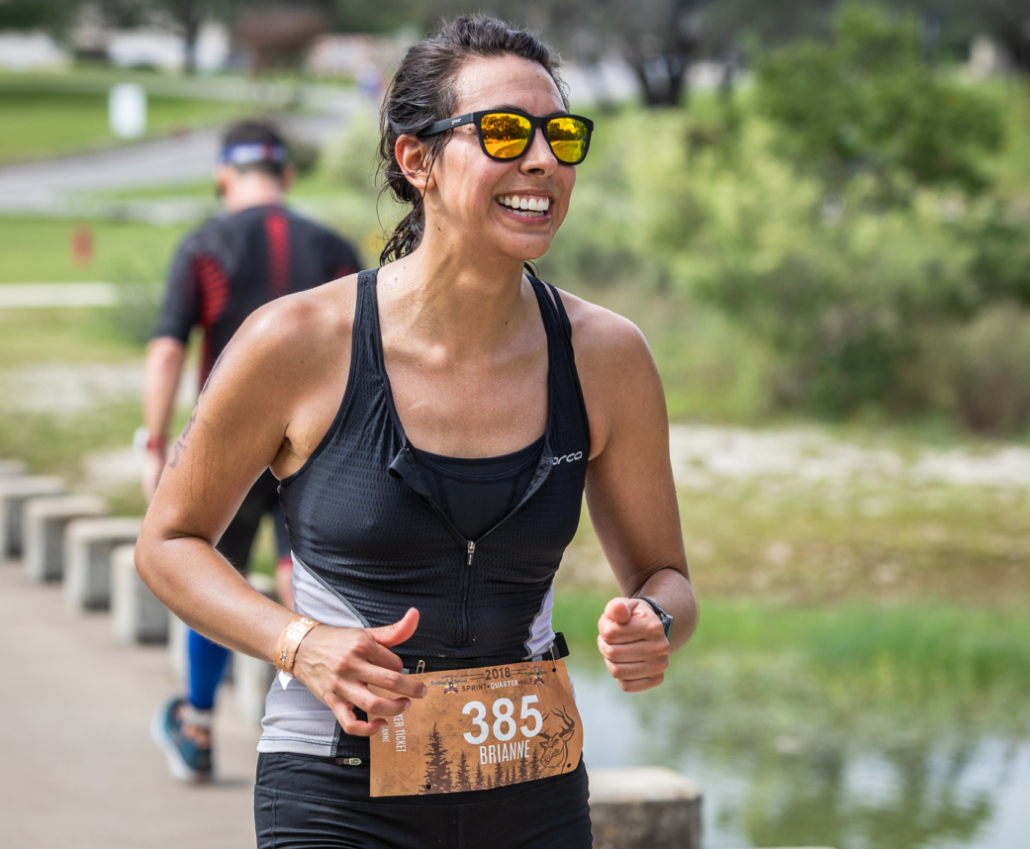
Avoid common foot problems and you’ll smile all the way to the finish line.
Tendons are fibrous tissues that connect muscles and bones. There are tendons all over our body and continuous wear and tear can lead to inflammation. This is also known as tendonitis. This is one of the more common foot problems since all three triathlon activities put a strain on the tendons. Running puts the most strain on your feet because of its repetitive nature. Swimming and cycling don’t create as much pressure, but your feet are instrumental for each discipline. Swimming and cycling are great ways to strengthen your feet, which is beneficial for running.
Shin splints
This is one of the more common and unwanted foot problems. It can range from muscle soreness to a stress fracture. Although there are several causes for this condition, two of the most common are old, worn-out running shoes and excessive training. Shin splints are most commonly associated with running. They can make things quite painful. If you experience shin splints, you can probably still ride your bike and swim, but you should probably skip a run or two. Reduce your chances of experiencing shin splints with this advice.
Blisters
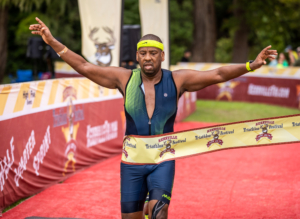
Blisters are painful, but they shouldn’t keep you from cross the finish line.
This is arguably the most common foot problem that triathletes experience. Blisters are a result of excessive friction between the feet and your shoes. They’ll mainly appear on your toes or the bottoms of your feet. Excessive moisture is typically the culprit, whether that be from sweat or water from the swim. But excessive rubbing of skin over a long period of time can also cause blisters to form. While blisters may not derail your training, they can be an inconvenience and cause pain.
Training for a triathlon is challenging and demanding. Every swim, ride, and run is important to achieving your goals. Your training should include enough time for your body to relax and recover, especially your feet and ankles. This is key to avoiding common foot problems. When your training plan calls for a rest day take it! They’re just as vital as any brick workout or long bike ride.
Learn about the 6 mistakes to avoid on your journey to the start line
Triathlon is an exciting sport that will test your limits, push your boundaries, and make you a better athlete. It consists of completing three activities – swimming, biking, and running – in a row. As with any new endeavor, there will be several unknowns and some mistakes along the way. It’s only natural! For those training for their first triathlon, one of your training and race day goals should be to keep the mistakes to a minimum. Learn about the 6 mistakes to avoid below. Doing so can make training that much easier and help you be even more successful on race day.
Make sure you avoid these 6 mistakes
Set unrealistic goals
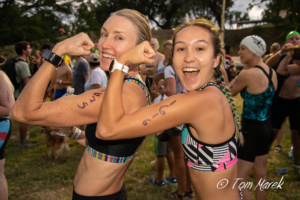
Choose a short-distance tri, like the Kerrville Tri Rookie Sprint, for your first triathlon.
View your first triathlon as an opportunity to explore the sport, meet new people, and learn something new. Setting unrealistic goals when you first start can cause stress and lead to disappointment and frustration. These goals could include finishing in a super-fast time or taking on a long-distance triathlon.
Instead, choose a short-distance triathlon, like the Kerrville Tri Rookie Sprint, for your first one. It consists of a 300m swim, 14-mile bike ride, and 2-mile run. This will allow you to learn about the nuances of triathlon while incorporating short-distance training. Set smaller, weekly goals that lead up to your main goal. This will keep you motivated.
Overlook nutrition and hydration
Don’t forget about what your body needs to propel you during your first triathlon: fuel. This includes nutrition and hydration. And we’re not just talking about training and race day. This includes all the meals you eat and what you drink. If you’re not a healthy eater, now’s the time to make the switch. Include more lean meats, fruits, and vegetables. Drink more water and electrolyte-enhanced drinks.
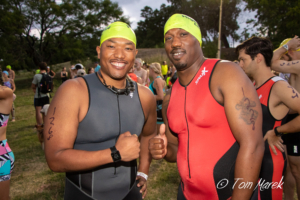
A well-rounded training plan will better prepare you for race day.
You need to know what your body will need on race day before race day. Test out what nutrition and hydration work best for you during training. Find your favorites and stick with them! This helpful nutrition guide will get you started.
Ignore a weakness during training
Focusing on your strengths will improve your performance for those specific activities. But focusing on your weakness is crucial to becoming a well-rounded triathlete.
For example, you might’ve grown up swimming, but aren’t that good at cycling. If this is the case, your training should focus more on getting better at cycling. This could include building your endurance, practicing bike skills, or learning the rules of the road. Don’t completely ignore swimming, just substitute a few swim workouts for bike rides.
Exclude triathlon gear
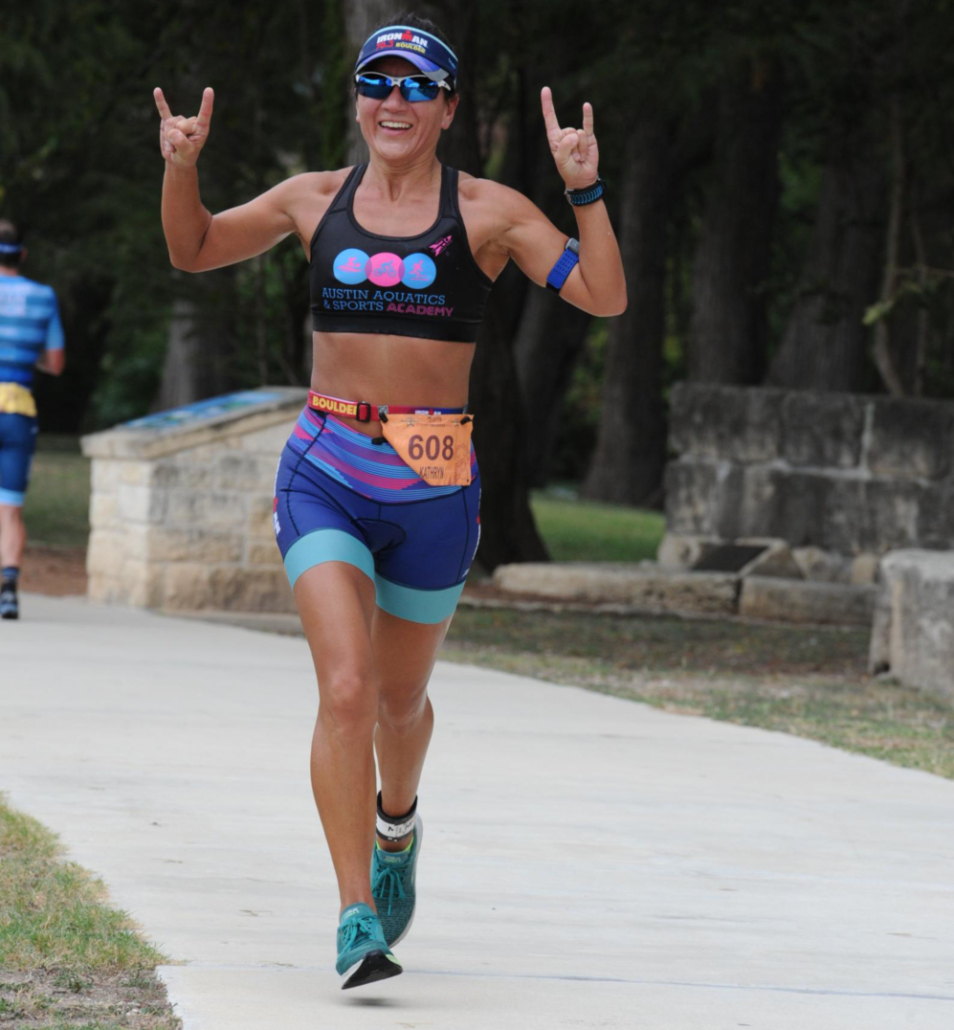
Remember: nothing new on race day!
Whether swimming, cycling, or running, triathlon gear is designed to improve performance and make you comfortable. You don’t need expensive equipment for your first triathlon, but you need gear that’s reliable and trustworthy. For example, a tri suit isn’t mandatory, but it’s something you can wear throughout your first triathlon. However, you will want swim goggles and a bike. If you’re in the market, read these bike buying dos and don’ts and learn how to find swim goggles that are right for you.
Try something new on the race day
Race day is not the time for experimentation. This includes gear, nutrition, hydration, and form/technique. Nothing new on race day! Trying something new on race day can result in issues that can affect your performance or worse, cause injury. What you use on race day should be tested multiple times during training. You should be completely comfortable with everything before race day rolls around.
Arrive late
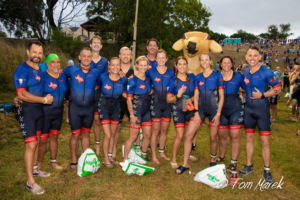
Another reason to arrive early: a group photo.
With so much to do in transition, you want to arrive early. You should be parked and headed to transition at least an hour before it closes, if not earlier. Give yourself enough time to set up in transition and become familiar with all the entrances and exits. When leaving your place, plan for traffic, rookie stress, and parking. Pro tip: practice setting up transition the night before and double-check everything when packing!
Learning about these 6 mistakes to avoid will save you time, reduce stress, and help you be successful during your first triathlon. This advice will stay with you during your entire triathlon journey.
